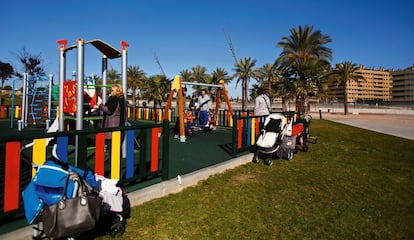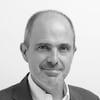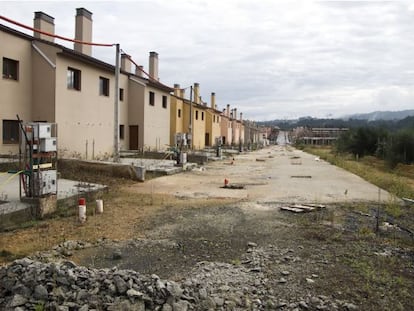Spain¡¯s ghost city comes to life
For years a symbol of the property crash, El Qui?š®n in Sese?a is starting to attract residents

Anybody who has passed Sese?a, 30 minutes south of Madrid on the A4 highway, and seen the so-called residential city of El Qui?š®n in the distance will probably have thought it a blot on the landscape, a crazed monument to all that went wrong during two decades of frenzied property speculation. But ask the people who live there what they think and they¡¯ll tell you a different story: they might not exactly be proud of the place, but on the whole they¡¯re happy to be there.
Granted, its wide, car-free streets are mostly void of traffic, even though the local census puts the number of residents here at 6,411, twice the figure of four years ago: that¡¯s because most of them are in Madrid, working. What¡¯s more, they park their cars in the garages underneath their apartment blocks. During weekdays, the only time of day when the streets come alive is during the twice-daily 15-minute school runs. After that, the silence returns.
Unlike many developments built in Spain during the 1990s and early 2000s, the architect did not stint on quality here
The majority of people living here are couples in their early thirties who moved here ¡°for the children¡± šC that, and the spacious, surprisingly well-built, and relatively low-priced apartments. It has to be said that there are still few amenities, but for the moment, most families seem happy with the swimming pool and gardens each apartment block is built round. The nearest cinemas require taking the car to nearby Pinto or Getafe, but then Aranjuez, 20 minutes away, has a population of 60,000 and no movie house.
El Qui?š®n is the brainchild of Francisco Hernando, better known as ¡°Paco el Pocero,¡± a man who rose from humble beginnings in the hard years of the 1950s to become one of Spain¡¯s most successful, and notorious, property developers.
Unlike many of the thousands of property developments built in Spain during the 1990s and early 2000s, one thing that has to be said is that Hernando didn't stint on quality when it came to building El Qui?š®n, something that surprises Alexandre Ratier, a Spanish-French architecture student who is preparing his doctoral thesis on the vast housing complex. ¡°You don't do a botched job and then name the park after your wife,¡± he notes, adding that there is even a statue to Hernando¡¯s parents on one of the roundabouts.

¡°One of the tragedies of Paco¡¯s life is that his father didn't live to see him triumph,¡± says Alfredo Urdaci, a well-known journalist who worked as Hernando¡¯s press officer between 2009 and 2012. ¡°Paco is a child of a certain time in Spain, hungry times, when only the quick and the brave survived. He is what he is, and later on encouraged this image of himself as illiterate, which is far from the case. He was an easy target, businessmen hated dealing with him. [...] He didn't understand how PR works and he was headed down a slippery slope. My job was to get him out of the media,¡± he says.
In the aftermath of the crash of 2008, journalists from all over the world made the trek out to Sese?a, dubbing it the ¡°ghost town¡± that symbolized the excesses of the property boom. Residents blame the media for its reputation and are still wary of talking to journalists.
But a real-estate agent based here is prepared to talk, and says that demand for apartments in El Qui?š®n is growing. The first people to move here, in 2007, paid up to 250,000 for a three-bedroom, 100-square-meter apartment. That was during phase one of the project, where around 3,600 people now live. The average price of the 2,300 apartments in phase two is now less than 100,000, up from the 50,000 they were being offered for in 2011.
?ngel PšŠrez, aged 33, bought a 100-square-meter apartment when phase two opened in 2011 for 90,000. He moved here from the historic town of Aranjuez, 20 kilometers away, saying he couldn't afford the minimum 130,000 asking price for a property there. He admits that this part of El Qui?š®n is deserted, but says he¡¯s confident that in time things will pick up.
This is the part of El Qui?š®n that journalists have largely focused their attention on. ¡°When I tell people I live here I have to explain myself,¡± says Maršªa Celada, aged 36. ¡°Even though my apartment is probably much better than theirs.¡±
It was thanks to the efforts of the Popular Party mayor Carlos Velš¢zquez in 2011 that the licenses required to open phase two of El Qui?š®n finally came through. ¡°We had to unblock the situation, look to the future; that¡¯s what residents here wanted,¡± he says. Hernando finally agreed to pay the 6.7 million he owed the local council, and water supplies were provided.

With this, El Qui?š®n finally became part of the municipality of Sese?a, a small community around five kilometers away, and a full range of services became available. Until then, those here were not just living in the middle of nowhere; they were living in legal limbo as well. Much remains to be done, and residents have a long list of requirements: a proper service road to the A4, a health center, another school, a nursery, better transport connections with Madrid¡
¡°We¡¯re doing okay, but there are still too many things that don¡¯t work,¡± says Antonio Martšªn, a civil servant with three children who moved here in 2012, and has already made several official complaints to try to get things moving. He has had to pay to take his youngest child to the nearest hospital, which is in Aranjuez, because the one assigned to Sese?a is 50 kilometers away in Toledo.
Many of El Qui?š®n¡¯s residents say life here is much better than it was in the cramped conditions they endured in the run-down and densely packed housing estates that sprawl across the south of Madrid, where many of them lived previously. ¡°I¡¯ve been in Spain since 2002, and lived in many places, and here I¡¯m very happy,¡± says 45-year-old Bo Zhang, who moved to El Qui?š®n in 2007 and now runs the local supermarket with her husband.
Few people in El Qui?š®n have a good word for the former mayor of Sese?a, Manuel Fuentes of the United Left party. He is the man who decided to take on Fernando Hernando, blocking phase two of the development. As a result, he was voted out of office in 2011. ¡°We did the opposite of all the corrupt mayors during those years, and at the height of the boom we upheld the law and the interests of everybody, but the voters turned against us,¡± he says. ¡°What can you do? The result is the problems we face today.¡±?
He says that Hernando asked him at their first meeting: ¡°Tell me what you want, ask for anything, and it¡¯s yours.¡± When he replied that he was acting on behalf of the electorate, the property developer told him that he was an idiot for being the only honest mayor in Spain.

So while the former mayor is regarded as pig-headed and somebody looking for a political fight, Hernando is well-liked, although listening to their stories, it¡¯s hard to know whether El Pocero is a saint or a gangster.
After making his first fortune at the age of 20, back in the mid-1960s, Hernando began cultivating friends in high places, such as JosšŠ Bono, a former Socialist Party minister and head of the regional government of Castilla-La Mancha, where Sese?a is located. El Qui?š®n¡¯s roots go back to the 1990s, when he built 12 houses nearby, then a further 800. He then says he had a dream, literally, to build a city in the desert, and set about constructing 13,000 properties, a task that arguably involved greasing a few palms. The Socialist Party mayor who approved El Qui?š®n in 2003, a former taxi driver called JosšŠ Luis Martšªn, is to stand trial accused of accepting a 2.4 million bribe. He claims he won the money on the lottery.
In 2004, Hernando was awarded the Spanish Labor Ministry¡¯s medal of honor by the Popular Party government of JosšŠ Maršªa Aznar. He now faces a tax bill of 86.1 million. He has kept a low profile since the collapse of the Spanish property market, trying his hand abroad in a number of failed projects in Saudi Arabia and Equatorial Guinea, and refuses to give interviews. That said, he still has many responsibilities in El Qui?š®n, such as changing the route of a high-tension electricity cable that passes perilously close to one apartment block.
¡°The leitmotif of Paco¡¯s life isn¡¯t money: I¡¯ve seen him turn it down šC what he¡¯s looking for is recognition. He wants to be able to say, ¡®I was nothing [...] I¡¯ve made it, and I¡¯ve built a city,¡¯¡± says Urdaci, who believes that Hernando¡¯s dream was simply to build luxury apartments for workers. He also believes Hernando wants to finish the other half of the Sese?a he dreamed would rise from the flatlands of Castilla-La Mancha. He may well realize that dream, but he¡¯ll have to wait until the Spanish property market recovers from its eight-year hiatus, and although signs of recovery are on the horizon, that might still take some time.
Tu suscripciš®n se estš¢ usando en otro dispositivo
?Quieres a?adir otro usuario a tu suscripciš®n?
Si continš²as leyendo en este dispositivo, no se podrš¢ leer en el otro.
FlechaTu suscripciš®n se estš¢ usando en otro dispositivo y solo puedes acceder a EL PA?S desde un dispositivo a la vez.
Si quieres compartir tu cuenta, cambia tu suscripciš®n a la modalidad Premium, asšª podrš¢s a?adir otro usuario. Cada uno accederš¢ con su propia cuenta de email, lo que os permitirš¢ personalizar vuestra experiencia en EL PA?S.
?Tienes una suscripciš®n de empresa? Accede aqušª para contratar mš¢s cuentas.
En el caso de no saber quišŠn estš¢ usando tu cuenta, te recomendamos cambiar tu contrase?a aqušª.
Si decides continuar compartiendo tu cuenta, este mensaje se mostrarš¢ en tu dispositivo y en el de la otra persona que estš¢ usando tu cuenta de forma indefinida, afectando a tu experiencia de lectura. Puedes consultar aqušª los tšŠrminos y condiciones de la suscripciš®n digital.










































